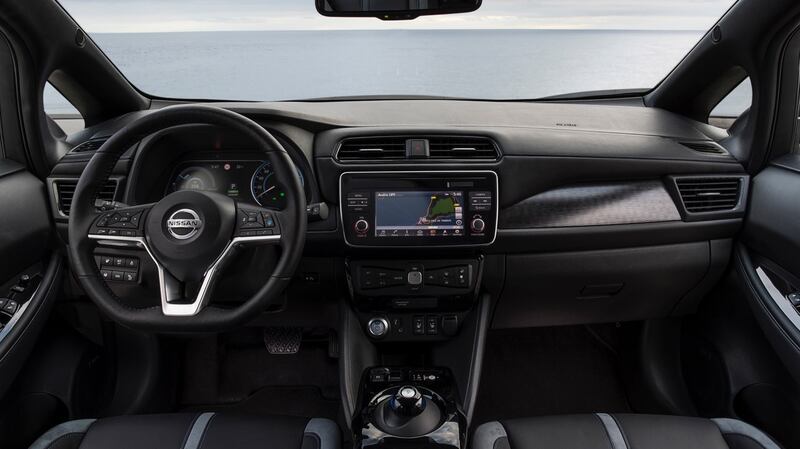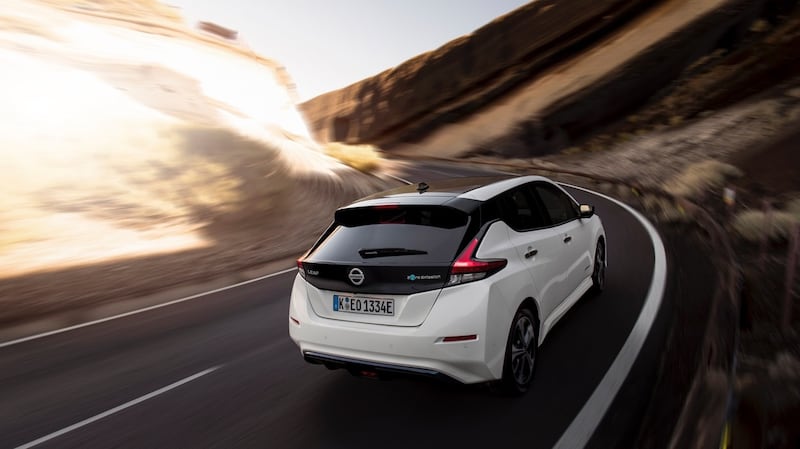It was a presentation which would have made Al Gore green with jealousy, rather than environmental angst. A Powerpoint presentation (all car launches are essentially 98 per cent Powerpoint presentations) which spoke of just what an impact on the environment the outgoing Nissan Leaf has had.
In eight years, Nissan has found 300,000 buyers for the first generation Leaf, and according to the Japanese car maker’s own figures, some 3.9-billion all-electric miles have been driven by those various Leafs, which has saved a claimed 1.2-million tonnes of Co2 emissions. Or, in one of those wonderful the-same-height-as-Liberty-Hall stats, the equivalent of growing 90-million trees, the same number which are grown in France each year.
So this, the second generation Leaf has quite the eco-shoes to fill. It is, though, quite a different car. The original Leaf, with its quirky, quasi-aquatic style and off-white interior was striking at which to look (not necessarily pretty, but I rather liked it) but almost deliberately divisive. The new Leaf looks far, far more conventional. The trained eye will pick up the subtle shapes and nuances of aerodynamic efficiency, but many a casual passer-by would mistake it for a facelifted Pulsar. That is, frankly, the intention. Leaf II has to take the baton of Leaf I’s pioneering spirit and make it mainstream, acceptable, normalised.



To do that, it has to become a car which normal people, not early-adopters with the fervour of converts, must consider as suitable for their needs, and to do that it has to have more range. The original Leaf could do between 100km and 160km on a really, really good day. The later versions, with a larger 30kWh battery, could maybe stretch to 190km in real-world conditions. This one can do 270km.
Real-life economy
Well, that’s according to Nissan’s figures, obtained from testing the car on the new World Light Duty Vehicle Test Procedure, or WLTP. The Leaf is the first car to publish its claimed figures for this new, and tougher, official fuel economy test, and the WLTP says that it will do 270km on a full charge on average, and as much as 415km if you keep it in town, maximising the benefit from regenerative braking. By comparison, its two most significant rivals - the Volkswagen eGolf (300km) and Hyundai Ioniq (280km) make their claims under the older, less stringent NEDC test. The Nissan’s number under that older test is 378km.
That’s thanks to a bigger battery. Well, bigger in terms of the amount of energy it can hold, as in spite of having 67 per cent more energy storage than the original, it occupies the same space. That extra battery capacity means that the Leaf weighs a husky 1,500kg at the kerb (including a driver) but you wouldn’t know that from its initial acceleration. Thanks to 150hp and 320Nm from its electric motor (up by 38 per cent and 26 per cent respectively) the new Leaf shunts off the line like the proverbial stabbed rodent (with a brisk 7.9sec 0-100km/h time) but actually the way it goes is not as interesting as the way it stops.
That’s because the Leaf is the debut car for Nissan’s new E-Pedal technology. E-Pedal is rather similar to what BMW has been doing for a while now with the i3 - basically, lifting off the throttle pedal triggers a sturdy amount of regenerative braking, using the electric motor to slow the car, which returns energy to the battery. As the car slows ever further, it also starts to use the physical brakes, without you ever touching the actual brake pedal, to bring the car to a steady and sedate stop. You’ll still have to use the brakes for sudden stops, but even on quite a steep downslope, there’s enough braking to allow you to use the car with just the one pedal.
For those keen on even lazier styles of driving, the Leaf is also rolling out the latest Propilot driver aid, which uses active cruise control and lane-keeping steering to help guide you along the motorway. It’s most definitely not autonomous driving, but it equally definitely takes the strain out of longer journeys.
Range anxiety
Can you actually do those longer journeys, though? Perhaps… I’m not sure I can quite make a definitive judgement on the Leaf’s useable range just yet. Our test route took us into the mountains of Tenerife, and it’s like the rally stage of your dreams up there (aside from the odd sightseeing coach or confused tourist in a hired Polo) so hardly the Leaf’s natural stomping ground.
For all the battery tech, your driving style still has the biggest influence on battery drain
Long, firm pushes on that E-Pedal reveal it has quite the appetite for straight-line performance, and can easily trigger its traction control on a tight, uphill corner. Such vertiginous enthusiasm left us a little short of range, so we had to slow things down a lot. At a brief stopover for coffee a Nissan official issued us a strict set of instructions of how to maximise range to make sure we made it back to base, the first time I’ve ever received such instructions on a car launch, but in fact we made it back easily enough, with 55km left in the battery, according to the dash display, having covered 162km.
Does that make it a truly useable electric car? Well, there are a number of imponderables in that question - known unknowns and unknown unknowns if you will. For all the battery tech, your driving style still has the biggest influence on battery drain, and clearly long motorway hauls are really not what the Leaf is designed for (although it is really rather gloriously refined when you do try them).
Better than before
It is most definitely a better car than its predecessor. The interior, equally as plain as the exterior in its style, has taken a significant step up in quality terms, and no longer rattles and squeaks over urban bumps as did the old one. There are some duff points - steering that adjusts for rake only, and a driver’s seat that sits too high for my taste, and the ride quality is less than smooth when the road gets rough - but arguably there are bigger things at play here. Nissan sees the Leaf as not just a car, but as part of a whole electric eco-system, and thanks to a specially designed wall-box it’s now possible to sell excess energy in your battery back to the national grid at peak times when the car is plugged in. Nissan says that, potentially, this could allow you to effectively run your car for free, but so far it’s only available in Japan, Denmark, and next year the UK. Don’t hold your breath waiting for Irish energy providers to catch up.

Is the Leaf still something of a specialist choice? Yes, in that you cannot easily haul one from one end of the country to the other, at least not without some serious forward planning. It is much less specialist, less limited than before and now it has some serious points in its favour - especially that sepulchrally silent cabin, and the simple fact that it’s on sale from the end of March; Nissan’s EV chief marketing officer, Franceso Giacalone sending a distinct shot across VW’s bows with the comment “it’s the best mass-market EV on sale today, not in 2020.”
It also appears to already be a success. In the three months since it was first revealed to the public, Nissan has taken some 12,000 orders, 7,000 of them existing Leaf owners. Nissan Ireland is not taking orders until the price tag is agreed (which should be broadly in line with the €28,000 Hyundai Ioniq and the €31,000 Toyota Prius, and will be announced by the beginning of February) but says that firm inquires, the sort that actually leave an email address and a phone number, are “like nothing we’ve ever seen.”
It’s probably tempting fate to suggest that the new Leaf might be the car to finally break the stranglehold of internal combustion on the market, but of course it won’t be - that day won’t come for a few years yet. It is likely to get more and more people behind the wheel of an all-battery car though, so Al Gore should have something positive for his next Powerpoint.
The lowdown: Nissan Leaf
Power: 150hp
Torque: 320Nm
0-100kmh: 7.9sec.
Top speed: 144kmh
Claimed range: 270km (on new WLTP test)
CO2 emissions: 0g/km
Motor tax: €120 Price: TBC
Verdict: Light of improved technology tucked under the bushel of more conventional looks. The electric car at last goes mainstream.
Our rating: 4/5











